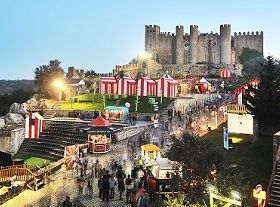Canas de Senhorim Carnival
Canas de Senhorim Carnival
Other
The development of the carnival in Canas de Senhorim has accompanied the town’s historical evolution. The carnival was launched following the formation of the neighbourhoods of Paço, where many nobleman lived, and Rossio, where the bourgeoisie and ordinary people lived. Given the social difference between the two neighbourhoods, it was perhaps inevitable that these two groups would confront one another in the Carnival – a unique time of denunciation and criticism, without anybody "taking offence".
Nowadays, two carnival marches continued to be organized. They advance through the town’s streets on the main Carnival day (Shrove Tuesday), and meet each another at the crossroads between the main street of the Rossio neighbourhood and the street that provides access to the neighbourhood of Paço. At this precise moment, the "revenge" takes place, in which the two groups dance and sing in a festive battle, in order to show who has greater conviction. The group that imposes its spirit of joy and happiness, is considered to be the winner of the carnival.
The Canas de Senhorim Carnival starts on January 6, Epiphany, with the "pots and pans" event. Originally, masked individuals entered the town’s streets at this time, and, taking advantage of the traditional peep-windows in the doors, would throw old clay pots into people’s houses, filled with ashes and gall-nuts that caused great noise and confusion. This custom gradually disappeared and the carnival festivities now officially begin on “Fat Sunday” (Carnival Sunday) when the two rival groups enter the streets, in preparation for the main Carnival procession on Shrove Tuesday.
On the Monday, the carnival celebrations are divided into two moments. The "Flour-throwing" festivities take place during the morning, when girls that leave their homes until midday run the risk of being showered in flour. In the afternoon, there is the “Old ladies’ Monday”. Ancient marches are sung and processions are held, with costumes that allude to the past. The opportunity is taken to organise two informal marches that ridicularise the proceedings of the general rehearsal held on the previous day.
The carnival festivities end on Ash Wednesday, with the burning of the "Entrudo" (“carnival clown”). After the "Batatada" (potato feast) -- a group feast in which the main dish is salted cod with potatoes, eggs, mint, bread and wine, the Carnival Clown is carried through the streets, signalling the end of the carnival. After reading the clown's will, the stuffed doll is burnt in public, thus signalling the end of the festivities and the beginning of Lent.
Nowadays, two carnival marches continued to be organized. They advance through the town’s streets on the main Carnival day (Shrove Tuesday), and meet each another at the crossroads between the main street of the Rossio neighbourhood and the street that provides access to the neighbourhood of Paço. At this precise moment, the "revenge" takes place, in which the two groups dance and sing in a festive battle, in order to show who has greater conviction. The group that imposes its spirit of joy and happiness, is considered to be the winner of the carnival.
The Canas de Senhorim Carnival starts on January 6, Epiphany, with the "pots and pans" event. Originally, masked individuals entered the town’s streets at this time, and, taking advantage of the traditional peep-windows in the doors, would throw old clay pots into people’s houses, filled with ashes and gall-nuts that caused great noise and confusion. This custom gradually disappeared and the carnival festivities now officially begin on “Fat Sunday” (Carnival Sunday) when the two rival groups enter the streets, in preparation for the main Carnival procession on Shrove Tuesday.
On the Monday, the carnival celebrations are divided into two moments. The "Flour-throwing" festivities take place during the morning, when girls that leave their homes until midday run the risk of being showered in flour. In the afternoon, there is the “Old ladies’ Monday”. Ancient marches are sung and processions are held, with costumes that allude to the past. The opportunity is taken to organise two informal marches that ridicularise the proceedings of the general rehearsal held on the previous day.
The carnival festivities end on Ash Wednesday, with the burning of the "Entrudo" (“carnival clown”). After the "Batatada" (potato feast) -- a group feast in which the main dish is salted cod with potatoes, eggs, mint, bread and wine, the Carnival Clown is carried through the streets, signalling the end of the carnival. After reading the clown's will, the stuffed doll is burnt in public, thus signalling the end of the festivities and the beginning of Lent.




 Explore
Explore 
 Remember and Share
Remember and Share 


